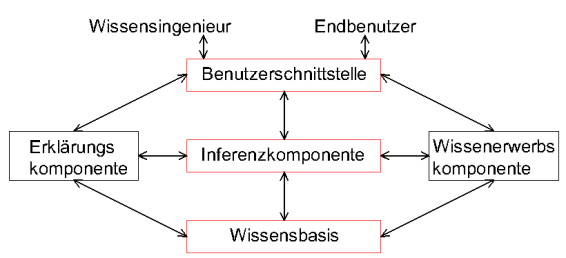Knowledge based system
A knowledge-based system (WBS) is an intelligent information system in which knowledge is mapped and made usable using methods of knowledge representation and knowledge modeling . The term is often used synonymously or as a generic term for expert systems , but it can also be used more generally for all knowledge-based systems.
classification
Knowledge-based systems can be viewed as a special type of programming system with which a new advantageous programming methodology becomes possible. They are preferably used to solve problems that are difficult to implement in an algorithmic , imperative way.
The inference machine is a calculation mechanism for programs given with the knowledge base . The inference engine is programmed by entering knowledge . The knowledge is represented declaratively . It consists of factual knowledge (similar to the data in a conventional database ) and rule knowledge , for example in the form of production rules ( if ..., then ... ), which are symbolically available.
Knowledge-based systems include:
A knowledge-based system is:
- easier to understand because it is sufficient to understand the independent, manageable units of knowledge,
- easier to correct because it is sufficient to check the correctness of the individual knowledge units and to change them if necessary,
- Easier to update according to the growing state of knowledge, especially in very diffuse subject areas.
In the vast majority of cases, expert systems are knowledge-based systems, even if these could be developed purely theoretically according to other principles. However, not every knowledge-based system is already an expert system. This requires some additional components which, in addition to being able to solve problems, equip the overall system with such usage properties that they can actually replace an expert.
Components / parts
The core components of a knowledge-based system are:
- Knowledge base - knowledge is stored here in declarative form, the knowledge comprises facts, rules and generic (problem area) as well as case-specific (problem-solving case) knowledge
- Inference component - knowledge of the knowledge base is processed here, with new facts and rules being derived
- UI (user interface) - interface for communication with the user or the knowledge engineer
In addition, especially for more complex applications - for example expert systems - there are also:
- Knowledge acquisition component - possibility to build up and expand the knowledge base (manually or automatically)
- Explanation component - Provides the user with information about the solution, so that he can understand it ( how and why )
Possible uses
- Data interpretation
- monitoring
- diagnosis
- therapy
- planning
- draft
- forecast
For example, knowledge-based systems in medical informatics are used to derive a problem solution (e.g. which diagnosis, which therapy) from the patient's data. Further possible uses and examples are described in detail under Expert System.
Development methods
There are various planning and development methods for planning and implementing a WBS. Here are to be mentioned:
